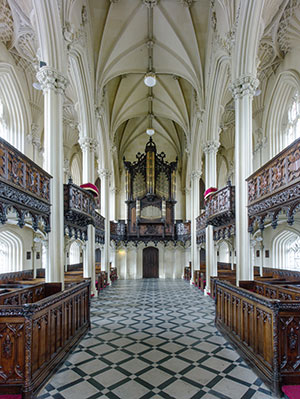Chapel Royal, Dublin Castle
Published in Gems of Architecture, Issue 1 (January/February 2017), Volume 25By William Derham

Above: Although resembling a creamy Caen stone, the interior is a timber structure covered in painted plaster. (David Davison/OPW)
James Gandon (1743–1823) prepared designs, now lost, for a new chapel but, wary of encroaching into the realm of the Board of Works’ architect, eschewed the job; it was 1807 before the board commissioned its own architect, Francis Johnston (1760–1829), to prepare a scheme. Johnston created a tour de force of architecture as theatre. More than a church, it was a stage for state ceremonies and the display of viceregal pomp, equalling any of the rooms in the State Apartments. The exterior, faced in limestone, is relatively ‘plain and simple’, in Johnston’s own words. ‘Relatively’ is an important qualification, however. It is ornamented with 103 heads, carved in Tullamore limestone by Edward and John Smyth, father and son, and representing kings, queens, archbishops and ‘grotesques’, together with a relatively early example of a carved Celtic cross.
In the nave, all sense of ‘plain and simple’ is left behind. Every surface of the interior is embellished. The nave has narrow galleried aisles, with an organ over the west door opposite an impressive east window. The overall impression is one of soaring height. Although resembling a creamy Caen stone, the interior is a timber structure covered in painted plaster. Plasterwork fan vaulting, inspired by Henry VII’s chapel at Westminster Abbey, is by George Stapleton (1777–1841), while modelled plasterwork heads are by the Smyths, likely the work of John after the death of his father in 1812. These heads lend an almost baroque feel. The galleries boast the coats of arms of former Irish viceroys, carved in wood by Richard Stewart.
The east window (1815) is by Joshua Bradley, the central panels—reputedly of northern European medieval origin—being a gift from the viceroy, Charles Whitworth (1752–1825), 1st Viscount Whitworth. In the centre of the nave’s east end, in front of the altar, an elevated, richly carved pulpit dominated the space, featuring the coats of arms of monarchs largely responsible for the Reformation and its consolidation—Henry VIII, Edward VI, Elizabeth I and William III.
Lord Whitworth presided over the opening of the Chapel Royal on Christmas Day 1814. Building and decoration costs had reached £42,350, in contrast to the original estimate of £9,532. A further £8,510 was spent the following year, bringing the total to over £50,000, a colossal sum. The Chapel Royal hosted its final service on Christmas Day 1922, after the dissolution of the viceregal court. A period of dormancy and occasional use ended when on 13 June 1943 the Catholic archbishop of Dublin, John Charles McQuaid (1895–1973), celebrated the first Mass in the building’s history, after which it became a garrison church for the Irish armed forces, renamed the Church of the Most Holy Trinity. Structural deterioration forced its closure in 1983. Between 1983 and 1990 its architectural fabric was consolidated and restored by the architects of the OPW.
William Derham works at Dublin Castle. He was joint editor, with Myles Campbell, of The Chapel Royal, Dublin Castle: an architectural history (Dublin, 2015). Series based on the NIAH’s ‘building of the month’, www.buildingsofireland.com.
















